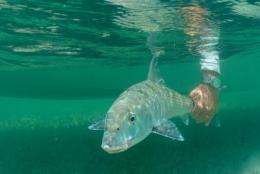Fall bonefish census sounds warning bell that warrants careful future monitoring

This October more than 60 guides and anglers in the Florida Keys poled across the flats from Biscayne Bay to the Marquesas, assisting in the annual bonefish census. This year's count, held in extremely difficult weather with lowered visibility, was down by 25-percent from an 8-year mean estimate of 316,805 bonefish to a new low of about 240,000 bonefish, according to Professor Jerry Ault, a fisheries scientist with the University of Miami's Rosenstiel School of Marine & Atmospheric Science.
"Since 2003 we have conducted an annual bonefish census throughout the Keys," said Ault. "It provides researchers, like me, and fisheries managers with an early warning system to identify trends and population changes." This year guides saw fewer bonefish in historically productive areas, a possible reflection of real population changes coupled with differences in the coastal environment. Future counts will be looking for evidence of this as an emerging population trend.
"Bonefish are a good indicator of overall ecological health. These highly mobile fish feed on small marine organisms at the base of the food chain like shrimps, crabs and baitfish; thus, the health of the bonefish population is greatly dependent on the status of the ecosystem as a whole. A change in the population is likely to signal greater issues throughout the coastal ecosystem and provide clues that we can study and address before the situation becomes critical," Ault added.
Ault suggests that if bonefish abundance did decline in 2010, it is still too early to pinpoint the reasons. However, he points out that last winter's January extended cold wave was particularly lethal to tropical gamefish species including tarpon, snook and bonefish, and to their prey. Water temperatures dipped as low as 44oF for periods of more than 3.5 days, and killed mostly small (and young) bonefish in Biscayne and Florida Bays.
The census, conducted in collaboration with local fishermen and guides, as well as the Bonefish & Tarpon Trust (BTT), and the Florida Keys Fishing Guide Associations, is important because bonefish are a major component of Florida's $5.5 billion sport-fishing industry. Based on past results, Ault estimates each bonefish in Florida is worth about $3,500 per year to the industry or about $75,000 over its lifetime.
"We are especially grateful to the guides and anglers of the Keys who continue to work closely with us because one of the great challenges we face is the lack of long-term historical data on the Florida bonefish population," said Tom Davidson, chairman of the BTT. "The datasets we are now developing are just the beginning. We are still learning about natural variations in these dynamic systems, so we can't really be sure yet about the significance of these ups and downs. However, these types of major population fluctuations will ensure that we remain vigilant."
Provided by University of Miami Rosenstiel School of Marine & Atmospheric Science

















